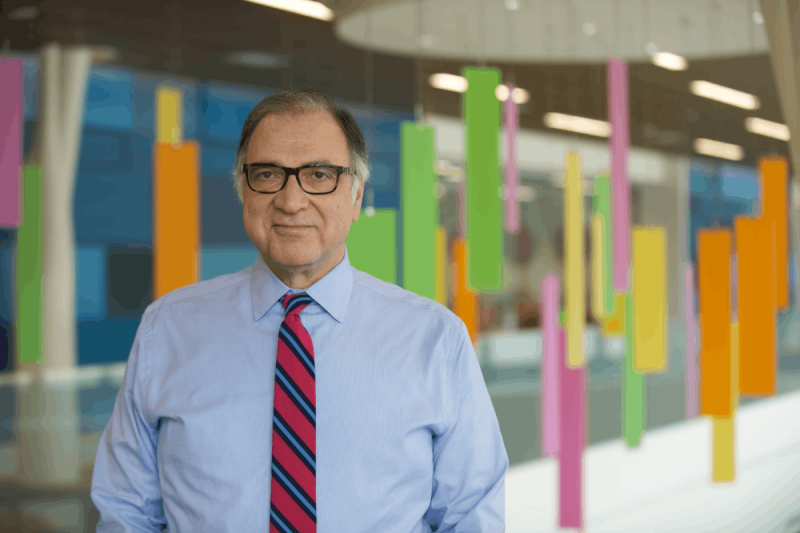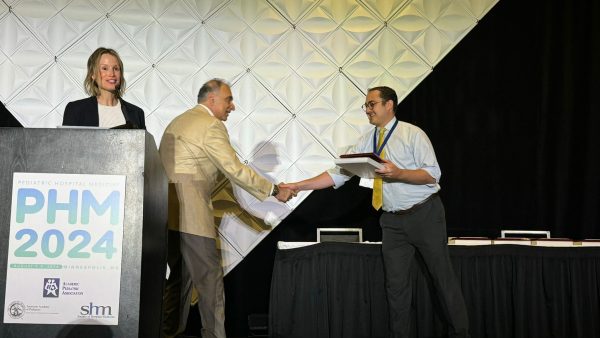
Akron Children’s director of hospital medicine Dr. James Nard was recently awarded the Pediatric Hospital Medicine Award for Excellence in Clinical Care.
James Nard, MD, began his career in hospital medicine before it was even an accredited, board-certified specialty. For more than 36 years, he dedicated his practice to improving medical outcomes and patient care standards in hospital medicine through pediatric care excellence, research and education.
Today, Dr. Nard is being recognized on a national stage for his outstanding achievements with the Pediatric Hospital Medicine (PHM) Award for Excellence in Clinical Care by the Academic Pediatric Association.
“I didn’t know I was nominated, so when I heard the news, I was absolutely speechless and very emotional because I’ve been doing this since before it was even called hospital medicine,” said Akron Children’s director of Hospital Medicine. “To be recognized by your peers for all that you’ve achieved in your career, not just clinically, but also through the development of essential programs and services, is a true honor.”
The PHM award recognizes pediatric hospitalists for excellent clinical leadership through development of clinical services or teams, growth or improved value of services, outstanding professionalism or outstanding leadership at the local, regional or national level.
On Aug. 3, Dr. Nard was honored and celebrated along with other winners at the Pediatric Hospital Medicine National Conference in Minneapolis, MN.
“Dr. Nard has had a profound impact on patients and all those who have worked closely with him. It’s physicians like him who push the boundaries and set new standards of excellence in health care,” said Shefali Mahesh, MD, Akron Children’s Pediatrician in Chief. “Now, with this national recognition, his expertise, clinical acumen and leadership will be celebrated on a broader scale. It is a great honor to have someone like him among us.”
Dr. Nard shares more about his achievements and the future of hospital medicine.

Dr. Nard (center) received the national PHM award at this month’s Pediatric Hospital Medicine National Conference in Minneapolis, MN. Photo courtesy of the Academic Pediatric Association.
Can you describe a few of your achievements in hospital medicine?
I joined Akron Children’s in 2005 to start a division of hospital medicine at a time when hospital medicine wasn’t a board-certified field of medicine. What began with 3 physicians has now blossomed to more than 60 hospitalists spanning 2 pediatric sites (Akron and Boardman).
During that time, I, along with my team, have developed the nation’s largest hospitalist-run pediatric sedation program, a neonatal hospitalist program with subsequent expansion to 3 sites in partnership with delivery hospitals, a pediatric hospital medicine APP program that has evolved from a consult/co-management service to a 24/7 service providing complex specialty care and an accredited pediatric hospital medicine fellowship program.
I’m also a professor of pediatrics at Northeast Ohio Medical University. I believe my strength lies in mentoring younger physicians, and to place people in positions where they will succeed.
How has hospital medicine evolved since you started?
Hospital medicine has gone from routine in-patient pediatrics when we first started to whole specialty care today. We still offer the same care, but our patient population has changed. Patients today have more complex issues that involve multiple subspecialties.
Thanks to advanced medical treatments (i.e., neonatology), more children are surviving conditions that they once may not have. There’s also an increase in chronic comorbidities, mental health and social issues that are creating more complex cases.
These kids don’t fit in any one specialty, and we are coordinating all these services and learning from a wide range of specialists. This has advanced our ability to care for complex kids with multisystem problems.
Best part of being a hospitalist?
The best part of hospital medicine is taking a sick child to discharge. It’s helping a patient transition to her new normal, whether that’s back to baseline or something else.
As a hospitalist, we’re captain of the ship. We handle patients with multiorgan issues and coordinate all their care, so we get to know them really well. That’s the most rewarding part of our role.
What work do you still hope to achieve here?
I hope to continue to build an attending-only physician program because I believe it’s key to the hospital’s future.
New guidelines are decreasing residents’ inpatient exposure, such as putting a cap on how many patients they service, and it’s creating staffing issues for hospitals.
Hospital medicine is taking on more and more basic subspecialty care for inpatients. The problem is when residents are capped on how many patients they can service, it inhibits our reach in the hospital and subspecialty providers may be asked to fill the gap. However, it doesn’t make sense to have a gastrointestinal provider, for example, manage the care of an inpatient when hospital medicine can provide general GI services.
So to help fill this resident gap, we are launching an attending physician-only service , in addition to our resident program, next summer. This way, our subspecialty providers can practice at the top of their field, and we’ll only utilize them to help with the most difficult and complex patients.
It’s neat to think we started in this specialty before it existed and now hospital medicine is at every hospital nationwide. It’s awesome to be a part of that transition, and I’m honored to continue to advance this field to offer patients the best care and outcomes possible.
Learn more about Dr. Nard and Akron Children’s hospital medicine services.










